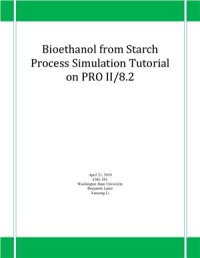
Ebook: Bioethanol from Starch. Process Simulation Tutorial on PRO II/8.2
Author: Lantz Benjamin Li Xuesong
Washington State University, April 21, 2010. - 23 p.
The process model is developed using PRO II/8,2
However, before creating a model in PRO II, the conversion rate from starch to glucose and glucose to ethanol need to be determined. The conversion rate for starch is based on the following journal article: Parameter Estimation for Simultaneous Saccharification and Fermentation of Food Waste into Ethanol Using Matlab Simulink by Rebecca Anne Davis. The conversion rate is based on 90 g/l of starch that produces 80 g/l of glucose which equates to 89% conversion rate. Next, to find the conversion rate from glucose to ethanol MATLAB will be used. This is done by simulating the growth kinetics of ethanol production from glucose using the rate equations listed below. The initial concentration of glucose is based on the above article.ContentsIntroduction to the project
General process of Bioethanol from Starch
Benefits of Using Model Simulation in Your Work
Bioprocess Simulation Model
Using Pro II 8,2: Production of Ethanol from Starch
Creating a new flow sheet
Setting up library and hypothetical components
Defining Reactions
Creating a Process Flow Diagram (PFD)
Creating Conversion Reactor (R1)
Creating Conversion Reactor (R2)
Creating Simple Heat Exchanger
Creating Distillation Column
Results
Appendix A
MATLAB Background
MATLAB Program
The process model is developed using PRO II/8,2
However, before creating a model in PRO II, the conversion rate from starch to glucose and glucose to ethanol need to be determined. The conversion rate for starch is based on the following journal article: Parameter Estimation for Simultaneous Saccharification and Fermentation of Food Waste into Ethanol Using Matlab Simulink by Rebecca Anne Davis. The conversion rate is based on 90 g/l of starch that produces 80 g/l of glucose which equates to 89% conversion rate. Next, to find the conversion rate from glucose to ethanol MATLAB will be used. This is done by simulating the growth kinetics of ethanol production from glucose using the rate equations listed below. The initial concentration of glucose is based on the above article.ContentsIntroduction to the project
General process of Bioethanol from Starch
Benefits of Using Model Simulation in Your Work
Bioprocess Simulation Model
Using Pro II 8,2: Production of Ethanol from Starch
Creating a new flow sheet
Setting up library and hypothetical components
Defining Reactions
Creating a Process Flow Diagram (PFD)
Creating Conversion Reactor (R1)
Creating Conversion Reactor (R2)
Creating Simple Heat Exchanger
Creating Distillation Column
Results
Appendix A
MATLAB Background
MATLAB Program
Download the book Bioethanol from Starch. Process Simulation Tutorial on PRO II/8.2 for free or read online
Continue reading on any device:

Last viewed books
Related books
{related-news}
Comments (0)